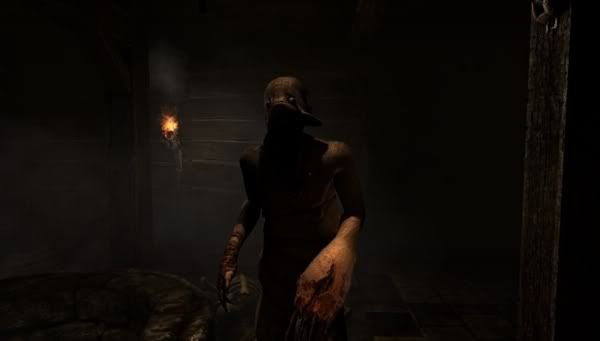This post has not been edited by the GamesBeat staff. Opinions by GamesBeat community writers do not necessarily reflect those of the staff.

Resident Evil (Biohazard in Japan) was released in 1996 and presented an original blend of atmospheric storytelling, limited resources and complex puzzles. It’s wildly entertaining – albeit horrifying – content, defined a new genre of gaming, one which Capcom dubbed ’Survival Horror’.
Although Resident Evil was not the first game designed with horror in mind – Capcom has cited inspiration from earlier spooky titles such as Alone in the Dark and their own Sweet Home – it differentiated itself by forcing the player to strategically consider their survival. Remaining aware of available resources and the least dangerous routes of navigation were vital to success, creating a successful style that many developers have attempted to emulate.
Mystery is the key
Jump forward 13 years and it’s difficult to recognize the franchise that defined survival horror. Beyond some familiar faces, Resident Evil has undergone a bizarre mutation in both gameplay and narrative, and while it’s amusing to compare this transformation to one of the many flesh eating monsters that have appeared in the franchise since its inception, the change has occurred due to necessity.
The most important element in survival horror is mystery, whether present through unexplainable enemies which tirelessly clamber to devour you or an atmospheric environment which presents more questions than answers, it is the sense of discomfort from not knowing or understanding the dangers around you that creates the strongest fear. However, as fans clamber for sequels to the stories they love, each new entry chips away at the mystery which initially kept them awake at night. After all, returning to Racoon City or arriving in Silent Hill for the umpteenth time could never carry the same impact as the first time we crept through their decrepit isolated streets.
In the face of such a challenge it becomes close to impossible to maintain interest in a franchise without aggressively changing its formula, but such action comes at the risk of eradicating the core concepts which initially attracted fans to it.
Innovation beats regurgitation
Of course some franchises have found success through changing their formula, and few are less relevant than the Resident Evil franchise, which, 9 years after its initial title and under renewed direction by Shinji Mikami, experienced a ground-breaking shift in Resident Evil 4. By incorporating precise aiming and movement controls, and drastically reducing the sense of vulnerability, it fundamentally redefined the genre it initially established.
Since then other franchises have proven that originality in the genre is still one of the most important factors to popularity. In late 2005 the original F.E.A.R was released to high acclaim thanks to combining a tense and atmospheric setting with fast paced shooting gameplay, something unseen before in the genre. And, although later entries in the franchise did well, they failed to capture the same feeling of dread that hung over the original. A prime example of how regurgitating a successful concept will not always garner similar adoration.
It’s difficult to berate developers who shake up the survival horror status quo, as with all genres innovation is required to evolve, however, while triple-A studios chase the allure of maximum profits and re-direct horror franchises toward action – reports already indicate that Mikami’s new game Evil Within looks more like Resident Evil 4 than 1, 2 or 3 – it is the Indie Developers who are tackling the tough job of taking the survival horror genre down a path closer to its roots.
Who is brave enough to support horror?
Judging by some of the games released in the last 5 years, it’s clear that Indie Developers can successfully extract key elements of the Horror genre to craft truly terrifying experiences. Amnesia: The Dark Descent and Slender: The Eight Pages, both gnawed at my psyche more than any game in years and did so while achieving impressive sales – Frictional Games reported sales in excess of one million units for Amensia.
Each title was designed to rob the player of confidence and control while forcing them to remain intellectually active to solve puzzles and progress. This combination means you can’t turn off your brain to regress and avoid fear. You must remain cognitively invested even though that makes it scarier, something which big budget horror titles have severely lacked in recent attempts.
Following the success of those games other studios are taking the vulnerability they established to new levels, such as Red Barrels’ Outlast, an upcoming stealth / horror title inspired by Amnesia, and Krillbite Studios’ Among the Sleep. Among the Sleep looks especially interesting to me due to its unusual take on the genre. This title, set for release in late 2013, is played through the eyes of a two-year-old child traversing dark and surreal environments created by their own imagination. Such a bold design attempts to tap into primal fears in the hope of attracting fans of horror, and considering the title exceeded its Kickstarter goal by nearly 25%, the choice appears incredibly effective.
Is it dead yet?
In conclusion we can see that survival horror isn’t dead, instead – much like a zombie meeting a chainsaw – it has split in-two. These two different styles are now heading in unique directions, where larger studios continue to push the genre toward action and adventure to attract greater audiences, while Indie Developers – who won’t sacrifice vision for sales figures – delve deeper into the core of fear.
If Indies maintain this stance, their bravery will provide fans with the scares they so desperately crave, ensuring that this particular brand of gaming horror continues to ‘survive’.
For this and other rambles, check out my blog or follow me on Twitter.
